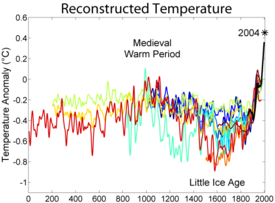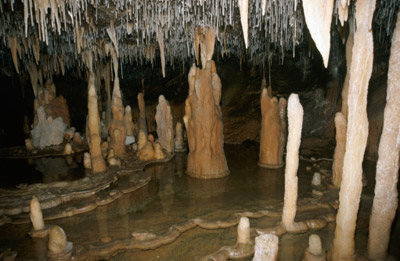MEDIEVAL WARM PERIOD
The Medieval Warm Period occurred from about AD 950- 1250,
during the European Middle Ages. It was
a time of warm climate in the North Atlantic region that may also have been
related to other climate events around the world during that time, including in

Initial research on the MWP and the following Little Ice Age
(LIA) was largely done in
Palaeoclimatologists developing region-specific climate
reconstructions of past centuries conventionally label their coldest interval
as "LIA” and their warmest interval as the "MWP”. Others follow the convention and when a
significant climate event is found in the "LIA” or "MWP” time frames, associate
their events to the period. Some "MWP”
events are thus wet events or cold events rather than strictly warm events,
particularly in central Antarctica where climate patterns opposite to the
By world region
Evidence exists across the world, often very sparsely, for changes in climatic conditions over time. Some of the "warm period” events documented below is actually "dry periods” or "wet periods”.
Globally
A study by Michael Mann et al. finds that the MWP shows
"warmth that matches or exceeds that of the past decade in some regions, but
which falls well below recent levels globally”.
Their reconstruction of MWP pattern is characterised by warmth over
large part of North Atlantic, southern Greenland, the Eurasian Arctic, and pars
of North America which appears to substantially exceed that of modern late 20th
century (1961-1990) baseline and is comparable or exceeds that of the past
one-to-two decades in some regions.
Certain regions such as central Eurasia, northwestern North America, and
(with less confidence) parts of
A radiocarbon-dated box core in the Sargasso Sea shows that the sea surface temperature was approximately 1 ºC warmer than today 1000 years ago (MWP).
The Vikings took seas to colonize
Prolonged droughts affected many pars of the western
Other regions
The climate in equatorial east
An ice core from the eastern
Corals in the tropical
Niño-Southern Oscillation patterns.
Adhikari and Kumon (2001), whilst investigation sediments in
Temperatures derived from an 18O/16O
profile through a stalagmite found in a

Stalactites
and stalagmites are what are known as speleothems, deposits of
minerals that form into cave structures and line the insides of a cave.
Stalactites are the formations that hang from the ceilings of caves like
icicles, while stalagmites look like they're emerging from the ground and stand
up like a traffic cone. Some may take thousands of years to form, while others
can grow quite rapidly. The two formations are also sometimes referred to
collectively as dripstone.
Note: (18O/16O) Oxygen isotope ratio cycles are cyclical variations in the ratio of the
abundance of oxygen with an atomic mass of 18 to the
abundance of oxygen with an atomic mass of 16 present in some substance, such
as polar ice or calcite in ocean core samples. The ratio is linked to water
temperature of ancient oceans, which in turn reflects ancient climates.


